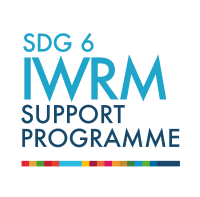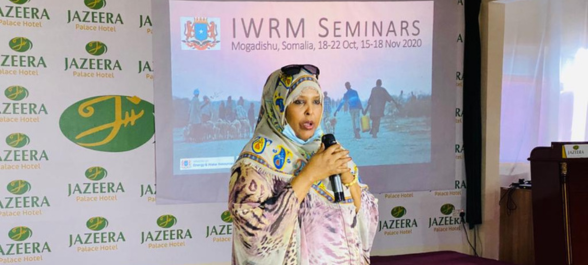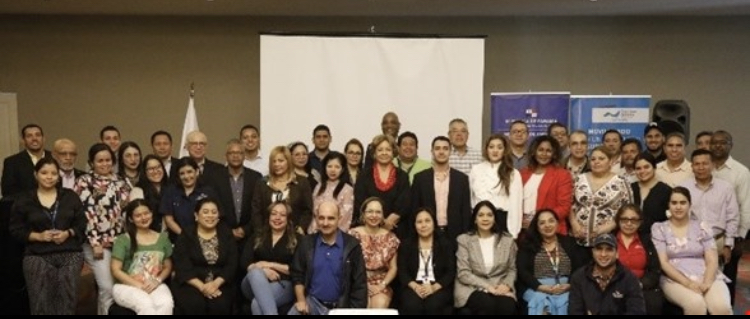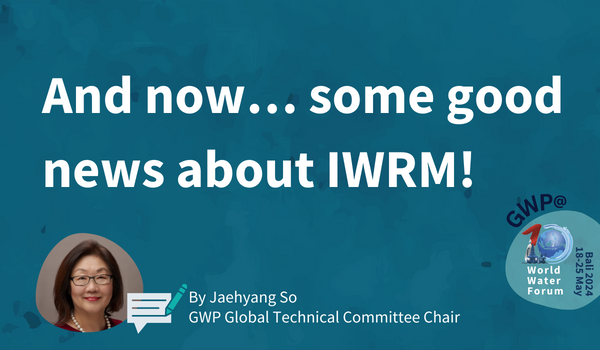By Jaehyang So, GWP Global Technial Committee Chair
UN SDG stocktaking | Three country snapshots reflecting real change | The power of IWRM and GWP | No one size fits all approach | AI | Working together...is what works
Water plays a profound and essential role in the world, in agriculture; industry; cities; and communities; it is a growth engine for our society and is essential to its life support system, the biosphere.
Conducted every three years, the UN SDG stocktaking exercise on integrated water resource management (IWRM) is the most comprehensive of its kind. Based on input from 183 countries, almost the entire world, this latest stocktaking exercise shows a steady positive trend: global performance on implementing IWRM – the essential strategic approach for improving water security – increased from 49% in 2017 to 57% in 2023. That eight-point increase ultimately translates to encouraging, large-scale positive changes in how countries around the world are managing their water resources.
 The number itself looks clear and simple; what you can’t see, however, is all the hard work by countries to actually change and improve the situation on the ground. As a formal partner to the United Nations Environment Programme (UNEP), through the SDG 6 IWRM Support Programme, GWP supports the massive country data collection undertaking, comprising almost a year of assessment, consultation, stocktaking, and multi-stakeholder processes at the country level. For this latest exercise, GWP supported almost 70 countries around the world through an inclusive, multi-stakeholder process, engaging over 4,000 stakeholders in the process.
The number itself looks clear and simple; what you can’t see, however, is all the hard work by countries to actually change and improve the situation on the ground. As a formal partner to the United Nations Environment Programme (UNEP), through the SDG 6 IWRM Support Programme, GWP supports the massive country data collection undertaking, comprising almost a year of assessment, consultation, stocktaking, and multi-stakeholder processes at the country level. For this latest exercise, GWP supported almost 70 countries around the world through an inclusive, multi-stakeholder process, engaging over 4,000 stakeholders in the process.
Three country snapshots reflecting real change
Here are three examples that provide some insight into the change in this number, reflecting real change on the ground:
Somalia

In 2017, Somalia reported the lowest score of all reporting countries, at 10% IWRM implementation. In 2023, Somalia’s score jumped to 34%, an increase of more than 300% compared to that baseline assessment, a remarkable transformation. Critical to the successful IWRM implementation is the country awareness and capacity to absorb and implement IWRM, and GWP’s support to Somalia included awareness-raising and capacity development for civil servants and key members of the water community to understand IWRM and good examples from around the world.
A key design point was that the training and facilitation was delivered by Somali lecturers. The Somali government has subsequently developed a curriculum which has since been replicating many times. A lot of other stakeholders have also supported Somalia in this period – the 10% score was a real alarm call that support was needed! And the ultimate result is an acceleration in the achievement of real water security for millions of Somalis.
Panama

Panama has abundant water resources but is increasingly threatened by the impacts of climate change. Droughts over the last decade in the Arco Seco region have been the worst in a century, leading to reduced agricultural production and prompting Panama to import staple foods. Reduced water availability also has a direct impact on the Panama Canal business, with 6% of global shipping making use of this route. With challenges on the horizon, the country’s Ministry of Environment (MiAMBIENTE) saw a serious need to speed up action for better water management.
GWP supported the government to create Panama's Action Plan for IWRM 2022-2026. The plan is a major step forward in water decision-making, with 35 key actions planned, prioritized and costed, with a total budget of USD 14 million. The government has already committed USD 3.36 million for the implementation of the plan. This momentum on the ground is behind the improvement in Panama’s score from 33% in 2020 to 40% in 2023. This translates to greater climate resilience, improved agricultural production, and significantly improved economic prospects for Panama.
Viet Nam

Today, Viet Nam is among the countries that are progressing most in improving their IWRM implementation, with a score of 56% in 2023, compared to 38% in its 2017 baseline. But this improvement is the result of a long-term, systematic approach to improving water resource management on the ground over several years. GWP supported the development of an IWRM Action Plan, which included recommendations based on future scenario analysis of anticipated water-use changes and climate change. The IWRM Action Plan led to financial support from UNDP, focusing on improved local water governance arrangements, including local water user groups, women’s unions, and youth unions, in the Mekong Delta. This plan is ultimately leading to better prospects for the people who live there, and better protection for local biodiversity.
The power of IWRM and GWP
These are just three brief snapshots of the significant changes being made on the ground to improve IWRM. IWRM as a concept is powerful in its simplicity: “the coordinated development and management of water, land and related resources to maximize economic and social welfare in an equitable manner, without compromising the sustainability of vital ecosystems”. This definition of IWRM was coined by my predecessors on the GWP Technical Committee almost 25 years ago. GWP was created in 1996 and its Secretariat was established as an intergovernmental organization in 2002 to advance the concept of IWRM, and since then it has grown to a global network with over 3,500 partners in over 175 countries around the world. GWP’s original objectives were successfully achieved: IWRM is globally accepted as a central framework to guide water management.
But there is no one-size-fits-all approach
Implementing IWRM, however, is devilishly complex. Every country and every water body is different, and as a result, the best approach to implement IWRM in each country must be developed and owned by the country and its people and institutions. To meet the demands from countries that want to move from IWRM concept to planning to implementation, GWP strengthened the network’s focus on supporting IWRM implementation through the following three strategic priorities:
1) Monitoring country status and tracking IWRM progress, and supporting countries to develop solutions, is the work of the SDG 6 IWRM Support Programme, coordinated by GWP under the guidance of the UN Environment Programme (UNEP) in collaboration with UNEP-DHI Centre and UNDP Cap-Net, and is of fundamental importance and a key strategic priority for the GWP network;
2) GWP’s second strategic priority is to support enhanced transboundary water management along the world’s 263 transboundary lake and river basins, which cover nearly half of the Earth’s land surface. A total of 145 countries include territory within international basins, and 21 countries lie entirely within international basins. Ability to navigate water sharing along transboundary water sources has direct impact in these countries; Vietnam, for example, gets about 60% of its water resources from transboundary rivers. Yet, so much of the support to countries is at the single country level; GWP’s Transboundary Programme provides the basic knowledge and the range of tools available to develop agreements, treaties, and other forms of cooperation; and
3) GWP’s third strategic priority is to support countries to meet the water challenges of the increasing impact and volatility from climate change. Under the global climate program, GWP supports countries to navigate the climate finance roadmap and to make the necessary progress towards sustainable investments. Additionally, in partnership with WMO, one of GWP’s founding partners, GWP’s programs on drought and flood help countries to develop practical and innovative solutions to address the increasing volatility in the earth’s atmosphere.
Keeping up with an evolving array of both challenges and opportunities … such as AI
However, doing everything we are doing now may not be enough in the future. Challenges to water management continue to evolve because the world is dynamic. An emerging issue is looming where there are still many unknowns: the intersection of technology and water. Technology has brought many positive developments to the world, and countries have used technology to improve IWRM, such as digital monitoring and online tools to greatly expand information dissemination, capacity building, and monitoring. The IWRM Action Hub, for example, can be accessed in real time in 94 languages. However, the rapid pace at which technology is moving, such as the development of AI, is also putting tremendous pressure on water availability. Headlining the World Economic Forum’s global risks report 2024 was the potential impact of AI, a topic on which there are so many different perspectives. Whereas the Rwandan Minister of Communications and Informational Technology spoke of the opportunity of AI to the Global South, UNSG Antonio Guterres warned of the “existential threat posed by the runaway development of AI”.
AI is changing our world more rapidly than we realize. What is less discussed is the heavy impact of AI on water and what should be done about it. AI requires huge amounts of water for cooling purposes. Globally, AI’s projected water usage could hit 6.6 billion m3 by 2027. One town in Iowa, the location of OpenAI’s supercomputers, has already brought a lawsuit on OpenAI’s excessive use of water, consuming 6% of municipal water supply in one month. Companies like Microsoft, Google, and Meta are vowing to mitigate their environmental impact by replenishing more water than they consume by 2030 through various ecological projects. But concrete plans are yet to come, and who will track these promises? While AI holds much promise for the world, countries need to better understand and prepare for its implications on water resources.
Working together … is what works
While no single stakeholder has all the answers to these emerging pressures on water resources, the fundamentals of IWRM are more important than ever to equip countries to meet these challenges. A multistakeholder approach, inclusive of all the users and uses of water resources, developing and implementing plans, are all fundamental capacity necessary to implement the IWRM framework. And the process works! The eight-point increase in 2023 over the 2017 SDG 6.5 average is an important indicator that the world is managing water better. There will be many speeches in Bali citing all the new threats to water security. It will be important to garner support and commitment for the intensive IWRM work to come to change the lives of people. But it will be also an important moment for all of us to acknowledge and celebrate the steady improvements by countries to manage the world’s water resources.

